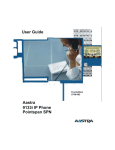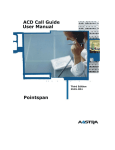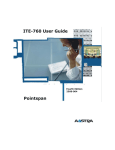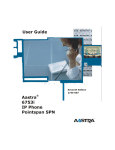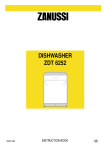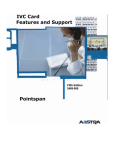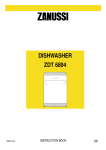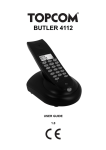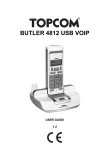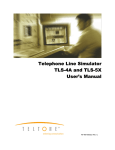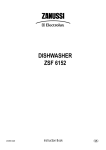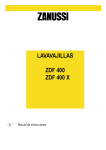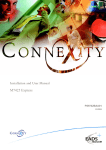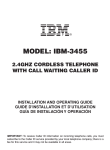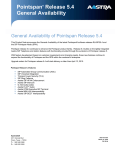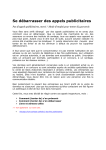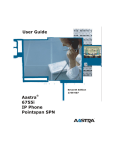Download ACD System Description
Transcript
Proprietary and Contents Section ii M M Aastra – 2541-003 Proprietary and Contents Section 3rd Edition (August, 2006) © Copyright 2006 Aastra Intecom Inc. All rights reserved. Information in this manual may change with product revisions. Aastra Intecom may add features or enhancements to the product(s) and/or program(s) described in this manual at any time. Technical Publications freezes the information in this manual based on the specified software and hardware releases. Publications writers incorporate such changes into newly released publication editions. Publications writers will incorporate any modifications provided to them after the publication release date into the next scheduled release of the publication. Aastra Intecom furnishes the application described in this manual under a license agreement and customers may use or copy information in the manuals only in accordance with the terms of the agreement. Contact Information Address any reader comments to: Aastra Intecom Customer Information Group Manager, M/S 1N 2811 Internet Boulevard Frisco, TX 75034-1851 You may also send email to [email protected] What to Expect when Contacting Company Technical Publications will email responses to customers within seven business days of the contact. Note that product support is not available through this email address. For product support, contact the Aastra Intecom Customer Service Center (CSC) at 1-800729-1872. Aastra Intecom may use or distribute review comments and information without incurring obligation. Trademarks and Acknowledgements Product registered trademarks and copyrights of the products included in this publication include Pointspan®, Centergy®, Centergy Remote®, Centergy Reporting®, and Centergy 5® as registered trademarks of Aastra Intecom Inc. Product trademarks and copyrights of the products included in this publication include Nexspan™, Unified Communication Platform™, Integrated Conference Manager™, and Movacs™ as trademarks of Aastra Intecom Inc. This publication identifies all other products or services mentioned herein by the trademarks, service marks, or product names designated by the companies that market those products. The companies producing these trademarks and registered trademarks control ownership of them. Make all inquiries concerning such trademarks directly to those companies. Aastra - 2541-003 M M iii Proprietary and Contents Section Revision History The following represents the revision history of this document: iv M M Revision Number Date Completed Point of Contact Description 003 August, 2006 Aastra Intecom Inc. Re-branding edits 002 June 2, 2005 Aastra Intecom Inc. Re-branded for Aastra 001 May 16, 2003 EADS TELECOM North America Technical Publications Initial release of this publication. Supports PointSpan version 3.0. Aastra – 2541-003 Proprietary and Contents Section Table of Contents 3rd Edition (August, 2006) .................................................................................................iii Contact Information ...........................................................................................................iii What to Expect when Contacting Company ......................................................................iii Trademarks and Acknowledgements.................................................................................iii About This Publication ......................................................................................................... vii Audience ........................................................................................................................... vii Publication Organization .................................................................................................. vii Conventions Used In This Publication ............................................................................. vii References........................................................................................................................viii Chapter 1 Automatic Call Distribution................................................................................. 1 ACD Applications............................................................................................................... 1 ACD Structure .................................................................................................................... 2 ACD Pilots.......................................................................................................................... 3 Call Guides ......................................................................................................................... 3 ACD Users.......................................................................................................................... 4 ACD System Capabilities ................................................................................................... 5 ACD Supervisor Features ................................................................................................. 10 ACD Agent Features......................................................................................................... 13 Agent States ...................................................................................................................... 16 ACD Constructs and Entities ............................................................................................ 17 ACD Equipment and Systems .......................................................................................... 22 ACD Capacity................................................................................................................... 23 Administrative Console Control for ACD ........................................................................ 24 Administrative Console ACD Commands........................................................................ 24 Chapter 2 ACD Reports........................................................................................................ 31 ACD Report Application Principles ................................................................................. 31 Agent Average Report ...................................................................................................... 35 General Analysis Guidelines............................................................................................. 36 Aastra - 2541-003 M M v Proprietary and Contents Section Agent Call Source Tracking by Originating Pilot Number Report................................... 37 General Analysis Guidelines............................................................................................. 38 Agent Percentage Report .................................................................................................. 38 General Analysis Guidelines............................................................................................. 40 Agent Current Status Report............................................................................................. 40 General Analysis Guidelines............................................................................................. 43 Agent Continuous Status Report....................................................................................... 44 Dialed Number Identification System Report................................................................... 44 Pilot Number Current Report............................................................................................ 45 General Analysis Guidelines............................................................................................. 46 Pilot Number Accumulated Report................................................................................... 47 General Analysis Guidelines............................................................................................. 48 Pilot Number Hourly Report............................................................................................. 49 General Analysis Guidelines............................................................................................. 50 Call Profile Report ............................................................................................................ 51 General Analysis Guidelines............................................................................................. 52 vi M M Aastra – 2541-003 ACD System Description About This Publication This publication provides general information on the Automatic Call Distribution (ACD) functionality of PointSpan switches. It explains what ACD is and does. Describing all ACD components and capabilities at a broad level, it conveys a conceptual understanding of ACD. Audience This publication supports anyone who needs information on the ACD functionality of PointSpan switches. Intended readers are call center professionals, including managers, planners, administrators, and supervisors. Publication Organization This manual contains the following chapters. Chapter, Topic Description Chapter 1, Automatic Call Distribution Provides an overview of ACD, including applications, users, capabilities, features, and components. Chapter 2, ACD Reports Describes the report generation capability of ACD. Includes a detailed description of each available ACD report. Conventions Used In This Publication This manual uses the following document conventions to help you identify different types of information. Aastra - 2541-003 Convention Description Example Angle brackets <> Key names Keys to press Press <Enter> to accept the default value. Bold text Characters to enter when referenced in a procedure In the example, select the DTMF group type. (Italics) Explanatory text within a command sample (Building Ports) Courier Example of output that a system displays Enter Password (and Username) M M vii About This Publication Convention Description Example Horizontal Ellipses Horizontal line omissions in a command sequence ... Vertical Ellipses Vertical line omissions in a command sequence . . . Provides supplemental information. The prompt may not display if … Provides information to help you avoid possible damage to hardware or a system crash (without data loss). Use case sensitive commands to keep from destroying… Provides information to ensure that you avoid danger, death, or permanent damage to a system. DO NOT touch exposed wires. Action column In a step/action/result table, contains an instruction. Type SPAR. Result column In a step/action/result table, contains anything important that the action causes to happen. The console displays the new parameter values. References The following publications provide related information. viii M M Publication Number Title Description 2470-nnn Centergy Reporting Supervisor Guide Supports call center supervisors in using the Centergy Manager application. 2471-nnn Centergy Reporting Server Operations and Maintenance manual Helps system administrators perform operations, maintenance, and troubleshooting functions through the Centergy Network Management Server (CNMS). Aastra – 2541-003 ACD System Description Aastra - 2541-003 Publication Number Title Description 2489-nnn IVC Card Features and Support Provides information and procedures to help customers implement and use the Integrated Voice Services (IVS) feature. 2494-nnn PointSpan System Operations manual Provides step-by-step instructions to operate and maintain PointSpan. 2498-nnn PointSpan System Description manual Describes the basic operations of PointSpan and its family of system products. 2503-nnn Centergy Reporting Administrator Guide Supports call center administrators in using the Centergy Manager application. 2506-nnn Centergy Reporting Reports Guide Describes the standard report templates that the Centergy Manager application provides. 2512-nnn PointSpan Station Database Procedures manual Provides step-by-step procedures to implement and maintain PointSpan stations and phone equipment. 2513-nnn PointSpan System Database Procedures manual Provides step-by-step instructions to implement and maintain PointSpan features, system functions, and configurations for cards, ports, and other switch components. 2516-nnn PointSpan Command Reference manual Defines the commands available through an administrative console to access and control the database of a PointSpan system. 2542-nnn ACD Administration Procedures Provides instructions to implement ACD and to enable individual ACD capabilities and features. 2545-nnn ACD Call Guide User Manual Defines the role of call guides in ACD. It also explains the functions of call guide commands, lists call guide design principles, and provides procedures to develop call guides. M M ix About This Publication Publication Number Title Description Various Quick reference and user guides for phones: Provide instructions for using the many phones and stations available with PointSpan. ITE-760 ITE-780 ITE-30SD ITE-12SD ITE Agent Phone x M M Aastra – 2541-003 ACD System Description Chapter 1 Automatic Call Distribution Automatic Call Distribution (ACD) is a feature of telecommunications systems that identifies and redirects incoming calls based on each call’s type and other properties. On PointSpan systems, ACD supports call centers. A call center is an environment in which groups of agents handle inbound and outbound calls. For example, many organizations use call centers to provide technical support or other information to customers. Other call centers help organizations process sales orders. Call centers provide many different functions and purposes. However, a core goal of any call center, regardless of its primary function, is to handle large call volumes efficiently. ACD is a core feature that greatly increases the efficiency of call centers by processing inbound or outbound calls and redirecting the calls to appropriate agents or agent groups. ACD Applications ACD supports a broad range of call center applications and many different kinds of organizations. Examples of call center functions that ACD supports include: • Account inquiry • Airline reservations • Customer service • Emergency services (E 911) • Government agency support • Home shopping services • National and international services (providing services across multiple time zones) • Order processing • Outbound telemarketing • Service and repair processing • Technical support • Telethons Aastra - 2541-003 M M 1 Chapter 1, Automatic Call Distribution ACD Structure Figure 1 shows the basic operational structure of Automatic Call Distribution (ACD). Callers (Clients, Customers) Callers Dial Call Center Number (1-800, 1-888, 911, etc.) Central Office Central Office routes calls to call center Call Center PointSpan Switch with ACD Switch translates dialed numbers and routes calls to steering pilots Steering Pilot (with Call Guide) Agent Group Pilot A Agent Group Pilot C Steering Pilot Distributes calls to agent groups (agent pilots) Agent Group Pilot B Agent A Agent C Agent G Agent B Agent I Agent H Agent D Agent F Agent E Figure 1. ACD Structure 2 M M Aastra – 2541-003 ACD System Description When an external caller dials the number for a call center (such as a 1-800 number), a central office routes the call to a PointSpan switch that supports that call center. The switch then translates the dialed numbers and routes the call to an ACD steering pilot. Based on the instructions in the steering pilot's active call guide, ACD distributes the call to an appropriate agent group pilot. An agent assigned to the pilot handles the call. ACD Pilots In a PointSpan switch, a pilot is a set of parameters that define ACD call processing. See "ACD Pilot Parameters" in the ACD Administration Procedures manual (2542-nnn) for a detailed description of each parameter and its possible values. Each pilot has a unique directory number (DIRN), typically four digits long. When an external caller dials the number for a call center (such as a 1-800 number), a central office routes the call to the switch that supports that call center. The switch then translates the dialed number into a pilot DIRN, such as 3000, and routes the call to the pilot. An internal caller can reach a pilot directly by dialing the pilot's DIRN. An ACD pilot can be one of two types: • Steering (or call type) pilot • Agent group pilot A call center requires at least one steering pilot, a primary pilot that contains one or more call guides. A call guide is a series of instructions, similar to a script, that specifies how ACD processes calls. Call guides typically route calls to appropriate agent group pilots, pilots to which one or more agents are assigned. An ACD system typically uses several pilots of both types to provide the complete routing function for a call center. PointSpan switches do not prevent the creation of pilots that are both steering pilots (those with one or more call guides) and agent group pilots (those to which agents are assigned). However, maintaining clear distinctions between steering and agent group pilots can help you implement a well-organized and more easily understood ACD system. In fact, the Centergy® call center management application specifically handles separate statistics for call types (for pilots with call guides) and agent groups (for pilots with agents). Any pilot with both a call guide and agents can cause confusing statistical data in Centergy. Call Guides A call guide is a series of instructions, similar to a script or program, that specifies how ACD processes calls, including how it routes calls to agents. Each instruction in a call guide is a step, each call guide can contain up to 255 steps, and each step contains one of the 32 available call guide commands (core instructions). Each call guide is an autonomous construct that can be assigned to any number of pilots. For details, see the PointSpan ACD Call Guide User Manual (2545-nnn). Aastra - 2541-003 M M 3 Chapter 1, Automatic Call Distribution ACD Users The following table defines different users of ACD. User Description Administrator A skilled call center professional who is responsible for the technical implementation and maintenance of ACD. An administrator, working alone or with a team of other administrators, uses PointSpan system consoles to define and maintain ACD parameters in switch databases. Agent An agent is one of the following: • A person who handles telephone calls or other communications in a call center. Call center agents range from inexperienced new hires to experienced professionals. • A channel or port on a device that processes calls or other communications for a call center. Agents are the recipients of calls that ACD routes to them. ACD agent stations make some ACD features, such as Wrap, Work, and Automatic Answer (Hands Free), directly available to agents. ACD station (line) and pilot parameters define which features are available to each agent. 4 M M Attendant A person, such as a company operator or receptionist, who works the console of a Private Branch Exchange (PBX). An attendant may be involved in routing some ACD calls. Caller The person who originates a call to a call center. Callers interact with ACD by responding to prompts for input, speaking with agents, speaking with supervisors, and otherwise completing transactions with the call center. Manager A person who is responsible for telephone systems for one or more call centers. Managers perform system analysis, system design, planning, budget control, and staffing. Some also act as administrators or supervisors. Planner A person who determines or otherwise defines the requirements of a call center and the functions it will provide. A planner may specifically assist in the design of ACD pilots and call guides to address a call center's requirements. A planner is typically an experienced call center professional, often in management, with strong technical background and skills. Aastra – 2541-003 ACD System Description User Description Supervisor A supervisor is a member of a call center with responsibility for the performance of assigned agents and agent groups. A head supervisor may also have responsibility for other supervisors. A supervisor is typically an experienced call center professional. Supervisor stations make some ACD features, such as Manual Overflow and Monitoring, directly available to supervisors. ACD station (line) and pilot parameters define which features are available to each supervisor. ACD System Capabilities ACD offers many core capabilities. Your total system configuration determines which capabilities are available. Capability Description Call Deflection This ACD capability routes calls to a quick conclusion when a pilot has too many calls in queue or any call has been in a queue too long. Destinations for call deflection include: • An alternate pilot • voice mail • recording device • answering service • busy signal Call Deflection differs from Overflow, which distributes calls in queue to alternative pilots when none of the agents in a primary pilot are available. Rather than routing calls to another pilot (and possibly waiting for the availability of an agent in that pilot), deflection terminates calls gracefully to avoid wasting callers' time and patience. Each ACD pilot contains its own Call Deflection parameters. The term Dynamic Call Deflection is synonymous. Aastra - 2541-003 M M 5 Chapter 1, Automatic Call Distribution Capability Description Call Distribution This core ACD capability defines the method ACD uses to route each call to an idle agent on line: • Longest Idle: ACD routes each call to the available agent who has been idle the longest • Ordered (Top Down): ACD routes each call to the available agent with the lowest idle queue priority value (ranging from a low of 1 to a high of 7) • Ordered (Bottom Up): ACD routes each call to the available agent with the highest idle queue priority (ranging from a low of 1 to a high of 7) Each ACD pilot contains a call distribution parameter that applies one of these methods. Call Forward No Answer This ACD capability handles calls that an agent in a pilot does not answer. Forwarding options include: • The system forwards the call in accordance with call forwarding parameters for the involved agent station. • The system leaves the agent on line, then queues the call to the same pilot again. • The system continues to ring the involved agent's station. • The system signs the agent off, then queues the call to the same pilot again. Call Guidance Each ACD steering pilot uses call guides to define how it processes calls, including how it routes calls to agents. Each call guide contains a series of instructions, similar to a script, that specify the processing steps for the pilot. A single steering pilot can use up to four call guides and an additional night call guide. Each steering pilot can contain its own Call Route Scheduling parameters to determine when each call guide is in effect. For details, see the PointSpan ACD Call Guide User Manual (2545-nnn). 6 M M Aastra – 2541-003 ACD System Description Capability Description Call Route Scheduling This ACD capability activates different call guides based on time of day (TOD), day of week (DOW), and day of year (DOY) tables. The time of day and day of week tables establish the timing needs of standard daily call center operations, including breaks, lunch hours, peak times, and weekends. The day of year table accommodates exceptionally different, non-standard scheduling, such as holidays. Each ACD steering pilot contains its own Call Route Scheduling parameters. Call Waiting Termination Each ACD pilot can enable or disable this ACD capability to determine whether the system will route a call to an agent station in the pilot when the station is busy with an active ACD call. CallNet This ACD capability supports overflow from a call guide of one switch to a call guide of another switch. The CNET (CallNet) call guide step controls overflow to another switch. A directory number from an agent group pilot associated with a Satellite Directory Group (SDGP) defines the overflow destination. CallNet enables a switch to overflow calls to one or more remote switches while maintaining calls in queue for agents on the local switch. For details, see the PointSpan ACD Call Guide User Manual (2545-nnn). CDR Agent Event This ACD capability generates an Agent Event Call Detail Record (CDR) for each agent in a pilot. The system records state change events, such as agent sign-on and sign-off, when the event occurs. It records other events with statistical calculations, such as the total duration of ACD calls, at time intervals based on the ACD CDR Event Period system parameter (the default period is hourly). At the quarter-hour time boundary defined by the ACD CDR Event Period, the system accumulates all the statistical durations and counts, records them to a new ACD Agent Event CDR for each agent, then clears the statistics. See "CDR Agent Event" in the PointSpan ACD Administration Procedures manual (2542-001) for details, including a list of agent event statistics. Aastra - 2541-003 M M 7 Chapter 1, Automatic Call Distribution Capability Description CDR Pilot Event This ACD capability generates a Pilot Event CDR for the pilot. The system records state change events, such as agent sign-on and sign-off, when the event occurs. It records other events with statistical calculations, such as the total duration of ACD calls, at time intervals based on the ACD CDR Event Period system parameter (the default period is hourly). At the quarter-hour time boundary defined by the ACD CDR Event Period, the system accumulates all the statistical durations and counts, records them to a new ACD Pilot Event CDR for the pilot, then clears the statistics. See "CDR Pilot Event" in the PointSpan ACD Administration Procedures manual (2542-001) for details, including a list of pilot event statistics. Destination Information Transfer This ACD capability determines what destination information the system transfers with an exiting call. Subsequent destinations, such as agent stations (for display) and voice mail systems, use this information. Digit Collection This ACD capability is a primary part of IVS. Digit Collection involves getting input from callers, usually in the form of dual-tone multi-frequency (DTMF) digits. It requires a digit collection template, a construct that defines the characteristics of the caller input to be collected. Each Get Digits step in a call guide uses a digit collection template. Different Get Digits steps can share the same digit collection template. For details, see the following: • The "Get Digits Step" and "Digit Collection" in the PointSpan ACD Call Guide User Manual (2545-nnn). • The PointSpan IVC Card Features and Support guide (2489-nnn). Directory Lookup This ACD capability includes agent names and agent identifiers (IDs) on ACD reports. Without Directory Lookup, ACD reports include only Agent IDs. Integrated Voice Services (IVS) The Aastra Inc. trademark for its interactive voice response (IVR) system. For details, see the IVC Card Features and Support guide (2489-nnn). 8 M M Aastra – 2541-003 ACD System Description Capability Description Intelligent Queuing This ACD capability gives each caller an anticipated wait time before an agent will answer the call. It helps a caller decide whether or not to continue to hold. As an option, the system can update the estimated time until answer while a call waits in queue. Interactive Voice Response (IVR) This ACD capability generates pre-recorded messages and prompts for caller input, usually the collection of dual-tone multi-frequency (DTMF) digits. Music This ACD capability plays music to callers while they wait in a pilot queue for agent answer, while on hold, during a transfer, or during phrases and messages. Network Numbering Plan Support This ACD capability supports the optional PointSpan Network Numbering Plan (NNP) capability. It allows ACD to support Inter-exchange Link (IXL) feature transparency with NNP. OAI Associated Member This ACD capability allows an ACD pilot to use an OAI channel as a link to an external application, such as: • Centergy® Manager • A call accounting application • An integrated voice response (IVR) unit • A reader board • A call recording system • A predictive dialing application • A voice mail system Originator Billing This ACD capability determines whether the system includes the originator as the billable party in a call's CDR, even if an agent or the system transfers the call. Overflow This ACD capability distributes calls in queue to alternative pilots when none of the agents in a primary pilot are available. ACD call guides typically use the Agent Group command (AGRP) with conditions to control overflow. For details, see the ACD Call Guide User Manual (2545-nnn). ACD can, however, enable supervisors to manually activate overflow to deal with high call volumes (see Manual Overflow in "Supervisor Features"). Report Generation Aastra - 2541-003 This ACD capability produces reports that assist in analyzing the efficiency and cost effectiveness of call center operations. See "ACD Reports" for details. M M 9 Chapter 1, Automatic Call Distribution Capability Description Short Abandon Time This ACD capability establishes a minimum time that a call must remain online before the system records it as an abandoned call. An ACD pilot parameter controls this capability. Short abandon time sets a threshold that filters out calls that may be abandoned for reasons that are not related to call center efficiency (such as call abandoned by callers who realize that they have dialed a wrong number). Whisper Messaging This ACD capability supports audio messages on a destination phone (typically an agent station) before ACD connects the incoming call. A whisper message typically provides information about the inbound call. For details, see the PointSpan IVC Card Features and Support guide (2489-nnn). ACD Supervisor Features ACD offers many supervisor features. Your total system configuration determines which options are available. ACD provides the flexibility to assign different options to different supervisors. Feature Description Audible Queue Status This feature, associated with the Calls in Queue feature, activates an audible alert (ring-ping) on a supervisor phone when the number of calls in queue exceeds the Queue Lamp Threshold (QLT). A supervisor hears the alert a second time when the number of calls in queue falls below the QLT. Calls in Queue This feature supports queue depth indicators on agent and supervisor stations. Stations with queue lamp indicators show the following: • Queue lamp off = no calls in queue • Queue lamp flashing slowly = Calls in queue are fewer than the Queue Lamp Threshold (QLT) • Queue lamp fluttering = Number of calls in queue exceed the QLT Stations with an alphanumeric display show the number of calls in queue and the number of agents currently on line. 10 M M Aastra – 2541-003 ACD System Description Feature Description Feature Control This feature enables a supervisor to control which ACD features are available to an agent. With the proper station configuration, a supervisor can: • Sign on for an agent (place the agent online) • Sign off for an agent (place the agent offline) • Activate or deactivate the Work feature for an agent • Activate or deactivate the Automatic Answer (Hands Free) feature for an agent. Force This feature enables a supervisor to manually suspend the Wrap and Work capabilities for all agents in an ACD pilot. It makes all agent stations that are in a Work or Wrap state immediately available to receive calls. Manual Overflow This feature enables a supervisor to manually route all calls in queue to any overflow pilots. Until the supervisor cancels manual overflow, ACD continues to route all calls to overflow pilots. To route calls again to the primary pilot, a supervisor must cancel manual overflow. This feature allows supervisors to adjust to unusual conditions. For example, Call Center 1 typically has ten active agents in the primary group. The center's call guide activates overflow when the queue holds more than five calls (one call waiting for every two active calls). On an unusual day, a snow storm hits the area, and only six primary agents make their way to the center. The supervisor can compensate for the staffing problem by manually activating overflow when the queue holds more than three calls (maintaining a ratio of one call waiting for every two active calls). For more information, see "Manual Overflow" in the PointSpan ACD Administration Procedures manual (2542-nnn). Monitoring This feature enables a supervisor to listen to or join an agent's conversation with a caller. The term Quality Monitoring is synonymous. For details, see "Monitoring" in the PointSpan ACD Administration Procedures manual (2542-nnn). Aastra - 2541-003 M M 11 Chapter 1, Automatic Call Distribution Feature Description Night Service This feature enables a supervisor to manually activate the pilot's night call guide. A night call guide supports a call center at times when agents are not available. Typically, Call Route Scheduling parameters activate the night call guide during anticipated down times, such as nights and holidays. With the Night Service feature, however, a supervisor can activate the night call guide in usual circumstances, such as emergency situations, when agents are unexpectedly unavailable. Play IVS Phrase This feature enables a supervisor to listen to IVS phrases stored on an IVC card. For details, see the PointSpan IVC Card Features and Support guide (2489-nnn). Queue Depth This feature enables a supervisor or agent to view the number of agents on line and the number of calls in queue on a station with an alphanumeric display. Reassignment This feature enables a supervisor to move one or more agents from one group to another. A supervisor can manually move agents through the Agent Continuous Status report. See "Move Agents from an Agent Continuous Status Report" in the PointSpan ACD Administration Procedures manual (2542-nnn). Report Generation This feature enables a supervisor to produce reports that assist in analyzing the efficiency and cost effectiveness of call center operations. See "ACD Reports" for details. Status Monitoring This feature enables a supervisor to check an agent's status. See "Agent States" for descriptions of possible agent states. A supervisor runs an Agent Current Status report or an Agent Continuous Status report to check agent status. For instructions to run these reports, see the PointSpan ACD Administration Procedures manual (2542-nnn). 12 M M Aastra – 2541-003 ACD System Description ACD Agent Features ACD offers many agent features. Your total system configuration determines which options are available. ACD provides the flexibility to assign different options to different agents or agent groups. Feature Description Agent Not Ready This feature is similar to the Agent Unavailable feature, but the agent is an external application that communicates with the PointSpan switch across an Open Application Interface (OAI) channel. The application activates and deactivates the feature. When Agent Not Ready is active, the switch does not route ACD calls to the application. When Agent Not Ready is inactive, the switch routes ACD calls to the application. Typically, Agent Not Ready supports an out dialer in a call center. Agent Sign-on An ACD agent must sign onto an agent group pilot to receive ACD calls. ACD provides the following methods for an agent to sign on: • Automatic sign-on • Manual sign-on with identification • Manual sign-on with identification and password • Dynamic sign-on • Roaming sign-on • Permanent sign-on For details, see "Agent Sign-on" in the PointSpan ACD Administration Procedures manual (2542-nnn). Agent Station Display Aastra - 2541-003 This capability displays incoming call information on agent stations with an alphanumeric display. Agent stations can display destination information (the billable number or agent's directory lookup name) for each incoming call. The system uses either the current pilot or a previous pilot to determine this information. Primary pilots typically display destination information for the current pilot. Overflow pilots, however, often display information that identifies the primary pilot from which a call arrives. M M 13 Chapter 1, Automatic Call Distribution Feature Description Agent Statistics This feature enables an agent station with an alphanumeric display to show statistics, such as the number of ACD calls received, for an agent. See "Agent Statistics" in the PointSpan ACD Administration Procedures manual (2542-nnn) for a complete list of the available statistics. Agent Unavailable This feature enables an agent to prevent ACD from routing new calls to their station. It gives agents the flexibility to manage their time when they need to take care of other duties or actions. ACD can be configured to require agents to enter a reason code after activating the Agent Unavailable feature. For details, see "Agent Unavailable" in the PointSpan ACD Administration Procedures manual (2542-nnn). Automatic Agent Sign-on This feature enables an agent to sign onto an agent group pilot without entering an ID or password. Automatic Answer (Hands Free) This feature enables agents using headsets to answer ACD calls without having to press a hook switch. Call Alert Option The means by which ACD announces an incoming call at an agent station. The four options are: • Standard ring (one standard ring) • Ring-ping (quick, short ring) • System feature ring (three quick rings) • No ring (agent line flashes) Call Recording This feature enables an agent to initiate call recording. It is particularly valuable when an agent is dealing with a hostile caller or an emergency situation, such as a bomb threat. Call Recording requires a recording device that is not standard PointSpan equipment. The term Emergency Call Recording is synonymous. 14 M M Aastra – 2541-003 ACD System Description Feature Description Calls in Queue This feature supports queue depth indicators on agent and supervisor stations. Stations with queue lamp indicators show the following: • Queue lamp off = no calls in queue • Queue lamp flashing slowly = Calls in queue are fewer than the Queue Lamp Threshold (QLT) • Queue lamp fluttering = Number of calls in queue exceed the QLT Stations with an alphanumeric display show the number of calls in queue and the number of agents currently on line. Do Not Disturb This feature places an agent station in a state that blocks incoming calls. When Do Not Disturb is active, the system forwards all calls to another destination (such as another line or voice mail). The pilot's Ring No Answer Forward Treatment parameter determines the destination. A station in Do Not Disturb state can place outbound calls. Typically, an agent activates the Do Not Disturb state by pressing a feature button on the agent station. An ACD pilot, however, can automatically place an agent station into Do Not Disturb when an agent signs off. Aastra - 2541-003 Dynamic Agent Sign-on This feature enables an agent to manually sign on to different agent groups (pilots). It provides flexibility in agent allocation. Manual Agent Sign-on This feature requires an agent to enter an Agent identification number (Agent ID), and possibly a password, to sign onto an agent group pilot. Permanent Agent Sign-on This feature causes an agent to remain signed onto an agent group pilot permanently. The only way to sign off an agent on the pilot is to place the port for the agent into maintenance out of service (MOS) mode. The Permanent Agent Sign-on capability is typically available to support external systems such as an integrated voice response (IVR) unit, that cannot sign on or off. Such systems must remain signed on at all times. Play IVS Phrase This feature enables an agent to listen to IVS phrases stored on an IVC card. For details, see the PointSpan IVC Card Features and Support guide (2489-nnn). Queue Depth This feature enables an agent to view the number of agents on line and the number of calls in queue on a station with an alphanumeric display. M M 15 Chapter 1, Automatic Call Distribution Feature Description Roaming Agent This feature enables an agent to relocate their assigned ACD voice line from one station to another while maintaining the same directory number. Work This feature enables agents to manually prevent their station from accepting more ACD calls. It gives each agent the flexibility to allocate additional time to complete paperwork or other duties before responding to other calls. Work, which is a manual application of the Wrap-up feature, shares the same feature button as Wrap-up on an agent station. Wrap-up This feature automatically provides up to 250 seconds after each call before an agent's station will accept another incoming ACD call. Wrap-up time allows each agent to complete paperwork or other duties before responding to another call. An agent can manually end wrap-up before the allotted time by pushing the Wrap-up button on the agent station (the same feature button that supports the Work feature). Agent States The following table describes all the possible states for ACD agents. 16 M M Agent State Description Busy on ACD The agent is currently busy handling an ACD call. Do Not Disturb The agent has activated the Do Not Disturb feature, which routes all calls coming into the station to another destination (such as another agent line or voice mail). The pilot's Ring Forward No Answer Forward Treatment parameter determines the destination. A station in this state can place outbound calls. Hold The agent has placed a current ACD call on hold. Idle/Available The agent is ready to receive incoming ACD calls. Incoming The agent is on an inbound, non-ACD call received by the ACD line. Internal The agent is on a call with another internal ACD line. Offline The agent is not logged in and the agent's station is not active in ACD. An offline agent is considered "off duty." Aastra – 2541-003 ACD System Description Agent State Description Online The agent is logged in and the agent's station is active in ACD. All other agent states except Offline are online states. Outgoing The agent is on an outbound, non-ACD call that they originated from the ACD line. Work The agent is in a manual work period that prevents the station from accepting more ACD calls. An agent uses work time to complete paperwork and other duties. Wrap-up The agent is in an automatic wrap-up period (up to 250 seconds following each call) that prevents the station from accepting more ACD calls. An agent uses wrap-up time to complete paperwork and other duties. ACD Constructs and Entities ACD relies on many software constructs and entities to perform its functions. Some constructs, such as ACD pilots, are critical to core ACD operations. Other constructs, such as digit collection templates, support only one or a few of the many ACD functions. Construct Function ACD Pilot A comprehensive set of parameters that define ACD call processing. Key ACD pilot parameters include: • Directory number • Call guide (see Steering Pilot) • Agents (see Agent Group Pilot) For a complete list, see "ACD Pilot Parameters" in the ACD Administration Procedures manual (2542-nnn). Aastra - 2541-003 Agent Group All of the call center agents within a single ACD pilot; see Agent Group Pilot. Agent Group Pilot An ACD pilot to which one or more agents are assigned (as opposed to a steering pilot, which has no agents). Agent Identification Number (Agent ID) A unique number that associates status information and statistics with a specific agent. Agent Line A telephone line dedicated for use by an ACD agent. Agent Super Group A combination of otherwise separate agent groups (pilots) in a call guide. Call processing treats the combined groups as a single, large agent group. The Agent/CallNet Super Group call guide command creates agent super groups. M M 17 Chapter 1, Automatic Call Distribution Construct Function Announcement A one-way message that an external device plays to callers in an ACD queue. The system does not accept caller input until the message is complete. A Speak Announcement step in a call guide activates an announcement. Annunciator Message A two-way message that a Voice Response Unit plays to ACD callers. Because the message arrives across a two-way connection, the system accepts input from a caller even while the message plays. A Speak Annunciator Message step in a call guide activates an annunciator message. Button Template A construct that defines the button layout of a phone, including which buttons are line select buttons, which buttons are feature buttons, and what feature each feature button controls. Call Guide A series of instructions similar to a script, that specifies how ACD processes calls, including how it routes calls to agents. Call Guide Command Any of 32 core instructions available for inclusion in a call guide. Each step in a call guide uses one of the 32 commands. CallNet Group An agent group that handles overflow from another switch. CallNet Super Group A combination of otherwise separate CallNet groups (agent group pilots on another switch) in a call guide. Call processing treats the groups as a single, large agent group. The Agent/CallNet Super Group call guide command creates CallNet super groups. Call Type A group of calls to a call center that share the same or very similar properties. In a PointSpan switch database, ACD pilots that contain call guides define call types. A pilot with an ACD call guide is often called a steering pilot, a product pilot, or a call type pilot. A call center's steering pilots reflect the types of calls that the call center is intended to handle. For example, a call center could have one steering pilot to direct callers to a technical support group and another to direct callers to an order processing group (this center's call types are "technical support" and "order processing"). 18 M M Aastra – 2541-003 ACD System Description Construct Function Call Type Pilot An ACD pilot that contains a call guide; see Call Type for more information. Class of Service A specific set of privileges and features that meet the specific needs of one definite class of users. Class of Service is a core construct of all PointSpan switching functions, not just ACD. Dialed Number Identification System (DNIS) Number In ACD, a DNIS number contains the digits that a caller entered to reach a call center. Digit Collection Template A component of a call guide that processes and validates direct input from a caller, usually in the form of dual-tone multi-frequency (DTMF) digits. Each Get Digits step in a call guide uses a digit collection template. Different Get Digits steps can share the same digit collection template. Directory Number (DIRN) An extension number assigned to a station, an agent line, or a supervisor line. Feature Button Any button on an ACD agent or supervisor station that activates an ACD feature. (Other buttons are line buttons, which support ACD directory numbers.) Hunt Group A set of telephone lines configured so that the switch, when it finds a phone line busy, searches subsequent lines in the set until it finds a free line. Incoming Call Announcement An announcement that, using the call's DNIS, audible identifies the type of incoming call on the agent's station. This type of announcement is very useful for agent phones that do not provide a visual display. IVS Group A set of Integrated Voice Controller (IVC) cards (associated by a common IVS Group number). IVS Phrase An audio phrase played by an IVC device (identified by an IVS phrase ID and an associated IVS phrase group number). A phrase can include speech, tones, music, or other forms of audio. The Speak IVS Phrase and Speak IVS Data call guide commands activate IVS phrases. Aastra - 2541-003 IVS Phrase Group A set of Integrated Voice Services (IVS) phrases (associated by a common IVS Phrase Group number). Line Button Any button on an ACD agent or supervisor station that supports an ACD directory number. (Other buttons are feature buttons, which activate or control ACD features.) M M 19 Chapter 1, Automatic Call Distribution 20 M M Construct Function Monitor Control List A switch database construct that determines which monitoring types are available to a supervisor and which agents a supervisor can monitor for each type. Night Call Guide A call guide defined specifically to support the call center when agents are not available (such as at night). A pilot uses a night call guide as defined by Call Route Scheduling or when a supervisor activates the Night Service feature. Overflow Group A group of agents who receive calls when none of the agents in another group (another agent pilot) are available. Typically, ACD call guides assign overflow groups, but a group may also be the target of manual overflow. Overflow Pilot An ACD pilot that receives calls when none of the agents in another pilot are available. Typically, ACD call guides assign overflow pilots, but a pilot may also be the target of manual overflow. Phantom Pilot An ACD pilot with a directory number that is not published, used within ACD call guides exclusively as an overflow pilot. Pilot Number A four-digit number that identifies a pilot. A pilot number is the directory number of an ACD pilot. ACD uses this number to route calls appropriately to idle ACD agents (members of the pilot). Prefix Digit Table An ACD construct that processes each ACD call and outputs the following: • The pilot's queue depth (initially and at subsequent intervals) • The call's estimated time until answer (initially and at subsequent intervals) Primary Group The agent group (pilot) to which ACD initially routes a call. The group which, by design, is intended to answer a type of call, if possible (as opposed to an overflow group, a secondary alternative). Queue A buffer for calls that are awaiting answer by an ACD agent. ACD temporarily queues calls while it seeks available agents to service them. Steering Pilot An ACD pilot that contains a call guide; see Call Type for more information. Step A single instruction in a call guide. Supervisor Line A telephone line dedicated for use by the supervisor of an ACD agent group. Aastra – 2541-003 ACD System Description Aastra - 2541-003 Construct Function User Group Any classification of users of a PointSpan switch, defined by sharing a set of core system parameters. M M 21 Chapter 1, Automatic Call Distribution ACD Equipment and Systems ACD involves many component systems and an array of associated equipment. The following table describes ACD-related devices and external applications, many of which are optional. 22 M M System or Device Description Administrative Console A terminal (also called a Man Machine Interface) that provides direct control over the many ACD parameters in PointSpan switches. It also provides access to ACD statistical records. For details, see "Administrative Console Control." Agent Station A phone station, associated with an ACD Pilot, that an agent uses to handle ACD calls. Alphanumeric Display A call center device (typically part of an agent station) that displays calling numbers, call center messages, and other information. Attendant Console A specialized telephone set used by attendants of a Private Branch Exchange (PBX). An attendant may become involved in routing some ACD calls. An agent station is designed to receive calls; an attendant console is designed to route them. Automated Attendant A voice processing device that automatically answers calls with a digital recording and allows callers to select a destination by entering an extension on their telephone's touchtone keypad. Centergy® Manager A PC application that integrates with PointSpan systems to enable effective call center and contact center management. Centergy Remote® An Internet service that enables remote agents to perform call center functions. The Centergy Remote service provides a graphical user interface on a Windows desktop and supports a separate agent telephone line connection. Centergy Remote does not require software installation or additional agent premise equipment. Integrated Voice Controller (IVC) Card A card in a PointSpan switch that implements the Integrated Voice Services (IVS) feature, which provides an interactive voice response (IVR) capability. Aastra – 2541-003 ACD System Description System or Device Description IVC Device A port on either an IVC card or IVC Module. Each card or module supports up to 72 ports or devices. The addition of more IVC cards or modules increases the number of available IVC devices. Each port on the IVC device can play IVS phrases and collect digits from callers. Each IVC device is associated with one IVS group. All IVC devices that are associated with the same group can access the same set of announcements and audio phrases. IVC Module A stand-alone hardware module connected to a PointSpan switch, that implements the Integrated Voice Services (IVS) feature, including the Interactive Voice Response (IVR) capability. IVS Phrase Manager™ A PC software application that organizes and maintains a database of sound files for use by an IVC Card or IVC Module. Supervisor Station A phone station associated with an ACD Pilot, that a supervisor uses to monitor ACD agents, handle ACD calls, and otherwise control call center operations. Voice Response Unit (VRU) A device within a PointSpan switch that uses a voice synthesizer to greet callers and to prompt callers for input. ACD Capacity The following table shows the ACD capacity ranges on a PointSpan switch. Your system's specific hardware and software configuration determine its exact ACD capacity. Aastra - 2541-003 Characteristic Capacity Range Number of Call Centers 1 to 64 Number of Agents 1 to 8000 Number of Supervisors 1 to 800 Number of ACD Trunks 1 to 10,000 Number of ACD Groups 1 to 4000 Number of Agents per Group 1 to 8000 Number of Supervisors per Group 1 to 64 M M 23 Chapter 1, Automatic Call Distribution Administrative Console Control for ACD System and station parameters in a PointSpan switch database determine the ACD functionality for that system. An Administrative Console (also called a Man Machine Interface) provides direct control over the many ACD parameters in a switch database and provides access to ACD statistical records. An administrative console can: • Create, modify, and delete ACD pilots • Create, modify, and delete call guides • Define Call Route Scheduling • Assign call guides to pilots • Assign agents to pilots • Determine feature access for agents and supervisors • Manage ACD reports For details regarding the Administrative Console, see "System Consoles" in the PointSpan System Operations manual (2494-nnn). For procedures that use the console to control ACD parameters in a PointSpan database, see the PointSpan ACD Administration Procedures manual (2542-nnn). Administrative Console ACD Commands The following table lists each administrative console command that controls or affects ACD functions and describes the command's role in ACD. Command (with Console Display) Role in ACD ACD Command The primary Automatic Call Distribution command creates, modifies, and deletes ACD pilots. The ACD command can: • Select a call distribution method for a pilot • Define call deflection for a pilot • Select a call alerting option for a pilot • Determine how a pilot handles calls in queue • Define work and wrap capabilities for a pilot • Enable the Agent Unavailable feature for a pilot • Assign up to four call guides and one night call guide to a pilot • Assign a supervisor to an ACD pilot • Enable Dynamic Agent Sign-on for a pilot • Define other core ACD functions for a pilot SELECT COMMAND => ACD See "ACD Pilot Parameters" in the PointSpan ACD Administration Procedures manual (2542-nnn) for details. 24 M M Aastra – 2541-003 ACD System Description Command (with Console Display) Role in ACD ACDC Command The ACD Call Guide command creates, modifies, and otherwise controls call guides and digit collection templates. SELECT COMMAND => ACDC See the PointSpan ACD Call Guide User Manual (2545-nnn) for details. ACDR Command SELECT COMMAND => ACDR The ACD Reports command generates and displays ACD reports. It also clears the statistics that ACD reports include. See "Report Generation" in the PointSpan ACD Administration Procedures manual (2542-nnn) for details. AGID Command SELECT COMMAND => AGID The Agent Identification command assigns ID numbers and passwords to ACD agents. The system uses Agent IDs to gather statistical information on each agent and to allow agents to sign on to agent group pilots. The AGID command can: • Specify that an agent can manually sign on without a password • Define a required password for an agent to manually sign on • Activate Dynamic Agent Sign-on for an agent • Activate Roaming Agent for an agent • Define other core ACD functions for an agent See "Agent Identification Parameters" and "Agent Sign-on" in the PointSpan ACD Administration Procedures manual (2542-nnn) for details. AMSG Command SELECT COMMAND => AMSG The Annunciator Messages command creates or identifies annunciator messages for inclusion (by number) in a call guide. See the PointSpan ACD Call Guide User Manual (2545-nnn) for details. BTNS Command SELECT COMMAND => BTNS The Buttons command creates, modifies, and otherwise controls button templates. A button template assigns features and line select buttons for appropriate ACD stations. See "Button Templates" in the PointSpan ACD Administration Procedures manual (2542-nnn) for details. Aastra - 2541-003 M M 25 Chapter 1, Automatic Call Distribution Command (with Console Display) Role in ACD CARD Command The Card command creates, modifies, and otherwise controls card configurations. The CARD command can configure Integrated Voice Controller (IVC) devices (the ports on IVC cards) to support Integrated Voice Services (IVS). SELECT COMMAND => CARD See the PointSpan IVC Card Features and Support manual (2489-nnn) for details. CLCN Command SELECT COMMAND => CLCN The Call Center command defines core information for a call center, such as name, location, time zone, and pilot member type. The pilot member type defines whether the system identifies agents in the call center by directory number (DIRN) or agent identification number (Agent ID). It determines whether the call center is "DIRN-based" or "ID-based." See "Call Center Parameters" in the PointSpan the ACD Administration Procedures manual (2542-nnn) for details. CLOS Command SELECT COMMAND => CLOS The Class of Service command defines sets of privileges and features that meet the varying needs of different kinds of users. Many Class of Service parameters pertain directly and exclusively to ACD. See "Class of Service Parameters for ACD" in the PointSpan ACD Administration Procedures manual (2542-nnn) for details. DIRN Command SELECT COMMAND => DIRN DRUP Command SELECT COMMAND => DRUP The Directory Number command creates, modifies, and otherwise controls directory numbers. The DIRN command can: • Display blocks of yet unassigned numbers in the database for assignment to ACD pilots • Create a feature DIRN that supports the Play IVS Phrase feature for stations without feature buttons; see "Assign a Feature Directory Number to Play IVS Phrases" in the PointSpan ACD Administration Procedures manual (2542-nnn). The Directory Lookup command creates tables of data for the system's Name and Number Directory. The DRUP command can add information for an ACD pilot to this directory. See "Add an ACD Pilot to the Directory Lookup Table" in the PointSpan ACD Administration Procedures manual (2542-nnn). 26 M M Aastra – 2541-003 ACD System Description Command (with Console Display) Role in ACD FONE Command The FONE command builds or deletes phones. The FONE command can: • Define whether a station supports ACD • Create stations and directory numbers for ACD agents and supervisors • Define whether an ACD station is an agent line or a supervisor line • Assign a Class of Service, directory number, and, button template to a specific port • Add agent lines to a supervisor station • Display the pilot in which a supervisor station port is defined • Define other core ACD functions for a station SELECT COMMAND => FONE See "FONE Parameters for ACD" in the PointSpan ACD Administration Procedures manual (2542-nnn). The FONE command can also associate a Monitor Control List and a supervisor station. See "Assign a Monitor Control List to a Supervisor Phone" in the PointSpan ACD Administration Procedures manual (2542-nnn). GRPS Command SELECT COMMAND => GRPS IVS Command SELECT COMMAND => IVS Aastra - 2541-003 The Groups command controls, modifies, and otherwise controls group information. The GRPS command can: • Display unassigned group numbers that are available for assignment to an ACD pilot • Display the group numbers assigned to an annunciator group (important during call guide creation) • Create and modify IVS groups; see "IVS Groups" in the PointSpan IVC Card Features and Support manual (2489-nnn). • Assign a whisper message for all calls from a specific trunk group; see "Assign a Whisper Message to a Trunk Group" in the ACD Administration Procedures manual (2542-nnn). The Integrated Voice Services command creates, modifies, and otherwise controls IVS phrase groups. See "IVS Phrase Groups" in the PointSpan IVC Card Features and Support manual (2489-nnn). M M 27 Chapter 1, Automatic Call Distribution Command (with Console Display) Role in ACD LINE Command The Line command assigns directory numbers to voice lines. The Line command can: • Modify some of the parameters of an existing station • Convert a standard voice line to an ACD agent line • Enable or disable the automatic sign-on feature • Configure a line to support the Play IVS Phrase feature SELECT COMMAND => LINE See "Line Parameters for ACD" in the PointSpan ACD Administration Procedures manual (2542-nnn) for details. MNTR Command SELECT COMMAND => MNTR The Monitor command creates a Monitor Control List (MCL). An MCL defines which monitoring types are available for reselection and which agents a supervisor can monitor for each monitoring type. See "Monitoring" and "Monitor Control List" in the PointSpan ACD Administration Procedures manual (2542-nnn) for details. NFIT Command SELECT COMMAND => NFIT The Numeric Feature Interpret Table command The NFIT command can: • Establish a two-digit code that removes a roaming agent line • Create a numeric feature code that supports the Play IVS Phrase feature for stations without feature buttons See "Roaming Agent" and "Play IVS Phrase" in the PointSpan ACD Administration Procedures manual (2542-nnn) for details. PDT Command SELECT COMMAND => PDT The Prefix Digit Table command creates, modifies, and otherwise controls PDT parameters. The PDT command can: • Create a PDT that supports the Intelligent Queuing feature • Create a PDT that supports the Whisper Messaging feature See "Intelligent Queuing" and "Whisper Messaging" in the PointSpan ACD Administration Procedures manual (2542-nnn) for details. 28 M M Aastra – 2541-003 ACD System Description Command (with Console Display) Role in ACD SDGP Command The Satellite Directory Group (SDGP) command displays, prints, and updates SDGPs. (The DIRN command creates them.) SELECT COMMAND => SDGP SDGP Command (continued) SPAR Command SELECT COMMAND => SPAR TEAM Command SELECT COMMAND => TEAM The SDGP command can modify an SDGP to support CallNet steps in call guides. See "CallNet" in the PointSpan ACD Administration Procedures manual (2542-nnn) and "CallNet Step" in the PointSpan ACD Call Guide User Manual (2545-nnn). The System Parameters command configures, modifies, and otherwise controls system parameters, features, resources, and switching partitions. The SPAR command can: • Enable the system to update estimated time until answer for calls in queue; see "Intelligent Queuing" and in the PointSpan ACD Administration Procedures manual (2542-nnn). • Verify that the switch has enabled IVS; see "Verify IVS Support" in the PointSpan IVC Card Features and Support manual (2489-nnn). • Set the time boundary for the system's generation of ACD CDR event records; see "Set the ACD CDR Event Period" in the PointSpan ACD Administration Procedures manual (2542-nnn). The Team command creates a team of agents that an MCL can assign to a supervisor for monitoring. See "Define an Agent Team for Monitoring" in the PointSpan ACD Administration Procedures manual (2542-nnn) for details. Aastra - 2541-003 M M 29 Chapter 1, Automatic Call Distribution Command (with Console Display) Role in ACD UGRP Command The User Group command controls user group parameters. The UGRP command can: • Control Dynamic Agent Sign-on; see "Modify a User Group to Support Dynamic Agent Sign-on" in the PointSpan ACD Administration Procedures manual (2542-nnn). • Support manual removal of a roaming agent line; see "Modify a User Group for Manual Removal of Roaming Agent Line" in the PointSpan ACD Administration Procedures manual (2542-nnn). • Associate a call center configuration with an appropriate user group; see "Add a Call Center to a User Group" in the PointSpan ACD Administration Procedures manual (2542-nnn). • Assign a whisper message for calls to a user group that supports Dialed Number Identification System (DNIS) definitions; see "Assign a Whisper Message to a User Group" in the PointSpan ACD Administration Procedures manual (2542-nnn). • Set the Whisper Device Wait (WDW) time, a delay before the system connects a call to allow a whisper device source to become available; see "Set the Whisper Device Wait Time" in the PointSpan ACD Administration Procedures manual (2542-nnn). • Select the statistics that the Agent Statistics feature displays and define the format for those statistics. See "Define the Format for Agent Statistics" in the PointSpan ACD Administration Procedures manual (2542-nnn). SELECT COMMAND => UGRP UTIL Command SELECT COMMAND => UTIL The Utilities command can build an Open Application Interface (OAI) channel to support the IVS Phrase Manager™ utility. See "Establish the OAI Channel" and "IVS Phrase Manager" in the PointSpan IVC Card Features and Support manual (2489-nnn). 30 M M Aastra – 2541-003 ACD System Description Chapter 2 ACD Reports Automatic Call Distribution (ACD) provides the following reports to assist in analyzing the efficiency and cost effectiveness of call center operations: • Agent Average report • Agent Call Source Tracking by Originating Pilot Number report • Agent Percentage report • Agent Current Status report • Agent Continuous Status report • Dialed Number Identification System (DNIS) report • Pilot Number Current report • Pilot Number Accumulated report • Pilot Number Hourly report • Profile report ACD Report Application Principles ACD can generate many reports that contain call center data, information that reflects the operations and status of a call center. The ACD reports include historical and real-time statistics, such as the total number of ACD calls handled, for individual agents, agent groups, and pilots. Historical data reflects the past operations of a call center. It helps you forecast future requirements, such as call volumes and staffing. ACD also provides real-time data that reflects the current state of a call center. Real-time data helps you make immediate responses to improve current operations. For example, you can move idle agents from one group to another group that currently has calls in queue. ACD reports help you manage the following aspects of a call center: • Resource allocation • Training and development • ACD Pilot performance • Agent performance • Customer satisfaction and quality • Service level requirements and regulations Aastra - 2541-003 M M 31 Chapter 2, ACD Reports The following sections associate specific ACD reports with aspects of call center management. See the "General Analysis Guidelines" section for each report to see how it specifically answers important call center management questions. Table 1 lists ACD reports that can help you allocate call center resources. Table 1. Resource Allocation Analysis Question Applicable Reports Does the center have enough agents? Pilot Number Current report Is the center supported by enough trunks? Pilot Number Current report Is the ratio of agents in primary and overflow pilots correct? Agent Current Status report Does the system need any more auxiliary announcements? How Many? Call Profile report (Overflow and Abandoned calls) Are calls being distributed to agents properly and efficiently? Agent Percentage report Agent Percentage report Pilot Number Current report Agent Average report Table 2 lists ACD reports that help you analyze training requirements. Table 2. Training and Development Analysis Question Applicable Reports Are agents providing immediate assistance to callers? • • Agent Average report Agent Percentage report • • • Agent Average report Agent Percentage report Agent Call Source Tracking by Originating Pilot Number report Agent Call Source Tracking by Originating Pilot Number report Agent Average report Agent Percentage report Agent Call Source Tracking by Originating Pilot Number report Agent Average report Agent Percentage report Which agents need more training? Are agent trainees ready? • Can agents handle more calls? • • • • • 32 M M Aastra – 2541-003 ACD System Description Table 3 lists ACD reports that can help you analyze the design and operations of your ACD pilots. Table 3. ACD Pilot Performance Analysis Question Applicable Reports Do some specific groups have high numbers of overflow calls? Agent Current Status report How many overflow calls does a pilot have? Are agents handling too many overflow calls, rather than handling calls to their primary pilot? When should supervisors use manual overflow? What is the best queue depth before a pilot routes calls to an overflow pilot? When should supervisor use the Force feature (to take agents our of Wrap-up and Work states)? When are the center’s peak busy periods? How can available agents be located during busy periods? • • • Agent Call Source Tracking by Originating Pilot Number report Agent Current Status report Agent Call Source Tracking by Originating Pilot Number report • Call Profile report (Overflow and Abandoned calls) • Call Profile report (Abandoned calls) • • • • • Agent Average report Agent Percentage report Call Profile report (Calls in queue and abandoned calls) Pilot Number Current report Pilot Number Hourly report • Agent Current Status report Table 4 lists ACD reports that can help you understand how effectively agents are handling calls. Table 4. Agent Performance Analysis Question Who are the most effective agents? Which agents are not performing well? Aastra - 2541-003 Applicable Reports • • • • • • Agent Average report Agent Percentage report Agent Call Source Tracking by Originating Pilot Number report Agent Average report Agent Percentage report Agent Call Source Tracking by Originating Pilot Number report M M 33 Chapter 2, ACD Reports Question Are agents staying in Work too long, not answering calls when they are available, or otherwise using the system inappropriately? Should agents use the Automatic Answer (hands free) feature? Are some agents either talking too long or ending calls to abruptly? Applicable Reports • • • Agent Average report Agent Percentage report Agent Current Status report • Agent Average report • Agent Average report Table 5 lists ACD reports that can help you evaluate the general effectiveness of the center in meeting customer needs. Table 5. Customer Satisfaction and Quality Analysis Question • Pilot Number Current report • Call Profile report (abandoned calls) • • • • • Pilot Number Current report Agent Average report Agent Percentage report Agent Current Status report Pilot Number Current report • Call Profile report (abandoned calls) How long does it take for a caller to reach an agent? • • Are callers being bounced around or is the first agent able to help them? • • Pilot Number Current report Call Profile report (calls in queue and abandoned calls) Agent Average report Agent Percentage report Is the center answering calls within the target service level? What should the target service level be? How can the center increase the percentage of calls answered within the target time? How many calls is the center losing? How quickly are callers abandoning calls? 34 M M Applicable Reports Aastra – 2541-003 ACD System Description Agent Average Report The ACD Agent Average report includes statistical averages for agents of the same group (those who share calls to a specific pilot number). It includes a name (if available) and an identification number (agent ID) for each agent. The statistics are historical, beginning from the last time Agent Report statistics were cleared. Each row provides statistics for a single agent. The last row provides a summary line that reflects the agent group's overall activity and productivity. It supports historical review and analysis of each agent's participation in pilot activities. Table 6 describes the statistical fields of an ACD Agent Average report. Table 6. Statistical Fields of an ACD Agent Average Report Field (Statistic) Description Total Pilot # Active Time The total time in which the pilot has not been in night service since this report was last cleared. Dir. Number The directory number of the ACD line on which a given agent last signed on. Agent ID A unique number that identifies a agent. Online Time The total time that a given ACD line has been in the online state. Online time includes the time that an agent is actively handling calls, in wrap-up, or in work. Unans Calls The number of calls that ACD routed to the agent that the agent did not answer within the time specified in the "call forward no answer" parameter. Xfrd Calls The number of calls that an agent initially received then transferred. # ACD Calls + Avg The top line shows the total number of ACD calls that the agent answered. The bottom line shows an average duration, based on the formula: Total ACD Call Duration / Total Number of ACD Calls Auto Wrap Avg The average time per call handled that the agent spent in the wrap-up state, based on the formula: Total Wrap-up Duration / Total Number of ACD Calls Avail Avg The average time that the agent was available to answer calls, based on the formula: Online Time - (ACD Call Duration + Wrap Duration + Work Duration) / Total Number of ACD Calls Answered Aastra - 2541-003 M M 35 Chapter 2, ACD Reports Field (Statistic) Description # Hold Calls + Avg The top line shows the number of times the agent activated call hold. The bottom line shows the average call hold duration for the agent, based on the formula: Total Call Hold Duration / Number of Calls Placed in Call Hold State # Outg ACD + Avg The top line shows the number of calls to an outgoing trunk that originated at the ACD line. The bottom line shows the average duration of outgoing calls, based on the formula: Total Duration of Outgoing Calls / Total Number of Outgoing Calls # Incm Calls + Avg The top line shows the number of non-ACD calls received by the ACD line. The bottom line shows the average duration of incoming non-ACD calls, based on the formula: Total Duration of Incoming Calls / Total Number of Incoming Calls # Intr Calls + Avg The top line shows the number of internal calls that the ACD line either originated or received. The bottom line shows the average duration of internal calls, based on the formula: Total Duration of Internal Calls / Total Number of Internal Calls General Analysis Guidelines Consider the following when reviewing and analyzing an ACD Agent Average Report: 36 M M • A comparison of an agent's time online to the total number of ACD calls that the agent handled indicates the agent's general performance level. • An agent may be ready to handle more calls or more difficult calls if: – The agent's number of ACD calls match that agent's number of incoming calls – The agent has no unanswered calls – The agent has no transferred calls • An agent who handles a relatively low number of ACD calls may require additional training or experience. • High numbers of outgoing, incoming, and internal calls may indicate one or more of the following: – The agent may be avoiding ACD calls – The agent may need more training – The agent may be performing unusual or special tasks (such as returning customer calls) Aastra – 2541-003 ACD System Description • High numbers of unanswered calls may indicate that an agent was either not at their station or was otherwise unavailable, but did not place the line in a work or unavailable state. • High numbers of transferred calls may indicate a need for more training. • High overall automatic wrap averages may indicate a need to decrease the maximum wrap-up time (WPM) for the pilot; see "ACD Pilot Parameters" in the ACD Administration Procedures manual (2542-nnn). • If a pilot has high numbers of unanswered calls, consider implementing the Automatic Answer (hands free) feature for agents. Agent Call Source Tracking by Originating Pilot Number Report The ACD Agent Call Source Tracking by Originating Pilot Number report tracks all calls to a pilot. This report shows the total number of calls to the pilot and the average duration of those calls. It indicates which agent groups (by pilot number) and agents (by name and ID) responded to calls to the pilot (and to any associated overflow pilots). Table 7 describes the statistical fields of an ACD Agent Call Source Tracking by Originating Pilot Number report. Table 7. Statistical Fields of an ACD Agent Call Source Tracking by Originating Pilot Number Report Field (Statistic) Description Total Pilot # Active Time The total time in which the pilot has been in active service (not night service) since this report was last cleared. Dir. Number The directory number of the ACD line on which the given agent last signed on. Agent ID The unique number that identifies the agent. Agent Name A name for the agent (if available). Orig Pilot The originating pilot number that routed calls to the specific agent. This field also includes any overflow pilots associated with the primary originating pilot. # ACD Calls The total number of ACD calls from the originating pilot and each overflow pilot that the agent answered. Avg Call Duration The average duration of the calls from the specific pilot (in the Orig Pilot column) that the agent answered, based on the formula: Total Duration of Calls / Number of Calls Agent Total # Calls Aastra - 2541-003 The total number of ACD calls from the originating pilot and all overflow pilots (the sum of all calls in the "# ACD Calls" column) that the agent answered. M M 37 Chapter 2, ACD Reports Field (Statistic) Description Agent Total Avg The average duration of all ACD calls from the originating pilot and all overflow pilots that the agent answered, based on the formula: Total Duration of Calls / Number of ACD Calls Answered General Analysis Guidelines Consider the following when reviewing and analyzing an ACD Agent Call Source Tracking by Originating Pilot Number report: • Call activity for primary pilots should typically exceed activity for overflow pilots. High numbers of call to overflow pilots may indicate a need for more agents in the primary pilot group. • An agent may be ready to handle more calls or more difficult calls if they are handling a higher number of calls with lower average call durations than other agents. • Agent trainees with low call durations are good candidates for assignment to primary and overflow pilots. • An agent's average call duration for a pilot that is much greater than the overall average call duration for the pilot may indicate that the agent needs training on handling calls to that pilot. Agent Percentage Report The ACD Agent Percentage report includes statistics for agents within the same agent group (those who share calls to a specific pilot number). It divides the total time for each agent across various call center activities (time handling ACD calls, time in wrap, time on hold, and more). It includes a name (if available) and an identification number (agent ID) for each agent. Each row provides statistics for a single agent. The last row provides a summary line that reflects the agent group's overall activity and productivity. This report supports historical review and analysis of each agent's participation in pilot activities. Table 8 describes the statistical fields of an ACD Agent Percentage report. Table 8. Statistical Fields of an ACD Agent Percentage Report 38 M M Field (Statistic) Description Total Pilot # Active Time The total time in which the pilot has not been in night service since this report was last cleared. Dir. Number The directory number of the ACD line on which a given agent last signed on. Agent ID A unique number that identifies a agent. Agent Name The name of the agent (if available) Aastra – 2541-003 ACD System Description Field (Statistic) Description Online Time The total time that a given ACD line has been in the online state. Online time includes the time that an agent is actively handling calls, in wrap-up, or in work. ACD Calls The percentage of total online time that the agent spent on ACD calls, based on the formula: Total ACD Call Duration / Total Online Time Auto Wrap The percentage of total online time that the agent spent in the wrap-up state, based on the formula: Total Wrap-up Duration / Total Online Time Work The percentage of total online time that the agent spent in the work state, based on the formula: Total Work Duration / Total Online Time Avail The percentage of total online time that the agent spent in the available (idle) state, based on the formula: Online Time - (ACD Call Duration + Wrap Duration + Work Duration) / Total Online Time Outgo Calls The percentage of total time that the agent spent on calls to an outgoing trunk that originated at the ACD line, based on the formula: Total Duration of Outgoing Calls / Total Online Time Incom Calls The percentage of total time that the agent spent on non-ACD calls received by the station, based on the formula: Total Duration of Incoming Calls / Total Online Time Intrn Calls The percentage of total time that the agent spent on internal calls that the ACD line either originated or received, based on the formula: Total Duration of Internal Calls / Total Online Time Time Hold The percentage of total time that the agent spent in the Call Hold State, based on the formula: Total Duration of Call Hold / Total Online Time Aastra - 2541-003 M M 39 Chapter 2, ACD Reports General Analysis Guidelines Consider the following when reviewing and analyzing an ACD Agent Percentage report: • The ACD Calls, Auto Wrap, Work, and Avail fields are 100% of an agent's time. • A comparison of an agent's individual statistics with values in the summary line indicates the agent's effectiveness relative to the agent group as a whole. • A comparison of the ACD calls and Avail fields may indicate efficiency, either of individual agents or of the agent group as a whole. • High Wrap, Work, or Time Hold values for an agent may suggest a need for more training. • High Wrap or Work values may suggest a need to enable supervisors to use the Force feature, which automatically takes agents out of Wrap-up and Work and makes them available to answer calls. • An agent who spends a large percentage of time handling outgoing, incoming (nonACD), or internal calls may be using the system inappropriately to avoid handling calls. • A low availability % for any agent warrants further investigation. Why is an agent less available than others? • A high availability % for the pilot as a whole (on the summary line) may indicate that the trunk may be underused. Agent Current Status Report The ACD Current Status report indicates the current (non-historical, present, real-time) status of all the agents for a specific pilot. Listing agents by directory number, agent identification number, and name, this report reflects the present status for each agent. The top of the report displays current statistics for the pilot as a whole. Table 9 describes the statistical fields of an ACD Agent Current Status report. Table 9. Statistical Fields of an ACD Agent Current Status Report 40 M M Field (Statistic) Description Calls Queued Provides the number of ACD calls currently in queue that originated to the pilot (PILOT = N). It also provides the total number of ACD calls currently in queue, including all overflow calls from other pilots (AGENT = N). Longest The longest time that any call currently in the queue has been waiting for answer by an agent in this pilot. # Online Agents The number of agents in this pilot who are currently online (signed on). Aastra – 2541-003 ACD System Description Field (Statistic) Description # Offline Agents The number of agents in this pilot who are currently offline (signed off). # Idle The number of agents in this pilot who are currently idle (and available to answer the next ACD call). # Wrapup The number of agents in this pilot who are currently in the automatic wrap-up state. # Work The number of agents in this pilot who are currently in the manual work state. # Hold The number of agents in this pilot who are currently in the hold state. # BsyACD The number of agents in this pilot who are currently handling an ACD call. # DNDstb The number of agents in this pilot who are currently in the do-not-disturb state. # Outgo The number of agents in this pilot who are currently on an ACD call that originated from an ACD line. # Incmig The number of agents in this pilot who are currently on a non-ACD call that an ACD line received. # Intrnl The number of agents in this pilot who are currently on an internal call that an ACD line either originated or received. # Unaval The total number of unavailable agents. # Notrdy The total number of agents who are not ready to receive and handle ACD calls. # Of Available Agent Statistic Blocks The number of agent statistic blocks for agent sign-on. When the percentage reaches 70% or more, the system displays the following: WARNING: XX% OF AGENT STATISTIC BLOCKS USED. AT 100% AGENTS WILL NOT BE ALLOWED TO SIGN ON UNTIL STATISTICS ARE CLEARED. When the percentage of blocks used reaches 100%, the system displays the following: WARNING: AGENT STATISTIC BLOCKS ALLOCATED. MUST CLEAR STATISTICS BEFORE ADDITIONAL AGENTS ALLOWED TO SIGN ON. Aastra - 2541-003 M M 41 Chapter 2, ACD Reports Field (Statistic) Description Arithmetic Mean for: The arithmetic mean time is a calculation that uses statistics from an ACD Profile report for a specified pilot number. Every time the system updates a statistic, it also recalculates the arithmetic mean time. This report provides means for the following: • Average abandon time (ABN=) • Average answer time (ANS=) • Average queue duration (QUE=) • Average overflow time (OVF=) • Duration since statistics last cleared (DUR=) Each of these fields will show "*****" until at least five instances of a certain call event have occurred. 42 M M DIRN The directory number of the ACD line on which the given agent last signed on. Agent ID The unique number that identifies the agent. Agent Name A name for the agent (if available). Aastra – 2541-003 ACD System Description Field (Statistic) Description Status The current status of an agent's ACD line: Display Meaning -OFFL- Offline IDLE Idle and available for an ACD call WRAPUP Wrap-up (automatic) WORK Work (manual) HOLD Hold BSYACD Handling an ACD call DNDSTB Do-not-disturb OUTGO On a call originated by the ACD line INCMIG On a non-ACD call received by the ACD line INTRNL On an internal call General Analysis Guidelines Consider the following when reviewing and analyzing an ACD Agent Current Status report: • Unlike the other ACD reports, the information in the ACD Agent Current Status is valuable immediately. Analyze this real-time report quickly to help you make immediate changes, such as moving agents from one pilot to another. • High numbers of queued calls for the pilot may indicate a need for more agents. • If the Calls Queued field indicates a large number of overflow calls (that is, the AGNT= value exceeds the PILOT= value), consider adding agents to the pilot that is the source of the overflow. • If the number of overflowed calls is greater than the number of calls answered and some agents are idle, consider moving one or more of the idle agents to the pilot that is the source of the overflow. • Comparing an individual agent's statistics against the arithmetic mean for the pilot as a whole can help you evaluate the agent's performance. • If a pilot with several agents in Wrapup or Work state is the source of overflow calls, consider applying the Force feature, which immediately returns the agents to an idle state, available to handle new ACD calls. Aastra - 2541-003 M M 43 Chapter 2, ACD Reports Agent Continuous Status Report The ACD Continuous Status Report is identical to the ACD Agent Current Status report, except that it updates automatically every 10 to 60 seconds. For instructions, see "Run an Agent Continuous Status Report" in the PointSpan ACD Administration Procedures manual (2542-nnn). You can manually move agents from one pilot to another from this report. For instructions, see "Move Agents from the Agent Continuous Status Report" in the PointSpan ACD Administration Procedures manual (2542-nnn). Dialed Number Identification System Report The ACD Dialed Number Identification System (DNIS) report provides statistical data for all DNIS calls to a call center since the statistics were last cleared. It tracks DNIS calls over periods from several hours to many days. Table 10 describes the statistical fields of an ACD DNIS report. Table 10. Statistical Fields of an ACD DNIS Report Field (Statistic) Description DNIS Dgts Identifies a DNIS number. Calls Offered The total number of calls to the DNIS number. Aband Calls The total number of calls to the DNIS number that a caller ended (abandoned) before an agent answered. Final Disp Calls The total number of calls to the DNIS number that reached final disposition (the end of an active call guide), whether handled by an agent or otherwise. Ans Calls + Avg The top value is the total number of calls to the DNIS number that agents answered. The bottom value is the average time until answer, in the form MM:SS, based on the formula: Queue Duration for Answered DNIS Calls / Number of Answered DNIS Calls 44 M M Answered - Norm The number of calls to the DNIS number that agents in the initial pilot answered (this number excludes overflow calls that agents answered). Answered - Auto Ovfl The number of calls to the DNIS number that agents answered after ACD routed them to an overflow pilot. Answered - Manul Ovfl The number of calls to the DNIS number that agents answered after a supervisor activated manual overflow. Aastra – 2541-003 ACD System Description Field (Statistic) Description Trgt % Ans < Tgt The top value reflects the Target Answer Time threshold. The botton value shows the percentage of calls to the DNIS number that agents answered within each pilot's Target Answer Time threshold, based on the formula: DNIS Calls Answered Before Target Answer Time / Total Number of Answered DNIS Calls Qued Calls + Avg The top value is the number of calls to the DNIS number that ACD placed in queue because no agent was available when they arrived. The bottom value is the average length of time, in the form MM:SS, that a call remained in queue, based on the formula: Total Duration of Calls in Queue / Total Number of Calls in Queue Qued Longst The longest duration, in the form MM:SS, that a call to the DNIS number remained in queue. Xfrd Calls The number of times that calls to the DNIS number were transferred. Report Dura HH:MM The total duration (interval) for this report, from the time a user last cleared the statistics until ACD generated this report. The time is in the form HH:MM. Pilot Number Current Report The ACD Pilot Number Current report provides statistical data for all calls to a pilot since the statistics were last cleared. It tracks a pilot over periods from several hours to many days. Table 11 describes the statistical fields of an ACD Pilot Number Current report. Table 11. Statistical Fields of an ACD Pilot Number Current Report Aastra - 2541-003 Field (Statistic) Description Pilot Dir (Ugp) The top value gives the pilot number. The bottom value, in parentheses, is the user group. Calls Offered (Deflc) The top value is the sum of ACD calls to the pilot that were either abandoned, reached final disposition, were answered, or were deflected. The bottom value, in parentheses, is the specific number of ACD calls to the pilot that were deflected. Aband Calls The total number of ACD calls to the pilot that a caller ended (abandoned) before an agent answered. M M 45 Chapter 2, ACD Reports Field (Statistic) Description Final Disp Calls The total number of ACD calls to the pilot that reached final disposition (the end of an active call guide), whether handled by an agent or otherwise. Ans Calls + Avg The top value is the total number of calls to the pilot that agents answered (including calls initially directed to the pilot and calls directed to the pilot as an overflow pilot). The bottom value is the average time until answer, in the form MM:SS, based on the formula: Total Queue Duration for Answered Calls / Total Number of Answered Calls Answered - Norm The number of calls initially directed to the pilot that agents answered (this number excludes overflow calls that agents answered). Answered - Auto Ovfl The number of calls that agents answered after ACD's automatic overflow function routed them to this pilot. Answered - Manul Ovfl The number of calls that agents answered after a supervisor activated manual overflow to route them to this pilot. Trgt % Ans < Tgt The top value is the target answer time, the number of seconds set as a threshold for agents to answer calls to this pilot. This threshold is an ACD pilot parameter. The bottom value shows the percentage of calls to this pilot that agents answered within this threshold, based on the formula: Calls Answered Before Target Answer Time / Total Number of Answered Calls Qued Calls + Avg The top value is the number of calls that ACD placed in queue because no agent was available when they arrived. The bottom value is the average length of time, in the form MM:SS, that a call remained in queue, based on the formula: Total Duration of Calls in Queue / Total Number of Calls in Queue Qued Longst The longest duration, in the form MM:SS, that a call remained in queue. Xfrd Calls The number of successful call transfers after answer. Report Dura HH:MM The total duration (interval) for this report, from the time a user last cleared the statistics for the pilot until ACD generated this report. The time is in the form HH:MM. General Analysis Guidelines Consider the following when reviewing and analyzing an ACD Pilot Number Current report: • 46 M M This report is useful to understand the system's daily operations. Aastra – 2541-003 ACD System Description • Any patterns in the incoming calls to a pilot can help determine scheduling requirements. • Increased numbers of abandoned calls at particular times or particular days may indicate a need for additional staffing for those periods. • If most abandoned calls are associated with a particular pilot, that agent group may need additional training. • High numbers of overflow calls may indicate a need for additional agents in the primary pilot group. • A percentage of calls answered less than 100% may indicate either a need for more agents or a need to increase the target answer time (in ACD pilot parameters). • High numbers of call deflections may indicate a need for more trunks. • High numbers of call deflections with high numbers of calls in queue may indicate a need to decrease wrap-up and work times. • High numbers of call deflections with low numbers of calls in queue may indicate a need for more agents. • Low numbers of call deflections with high numbers of calls in queue may indicate a need for more agents. Pilot Number Accumulated Report The ACD Pilot Number Accumulated report provides statistical data for all calls to a pilot since the statistics were last cleared. It tracks a pilot over periods from several hours to many days. Table 12 describes the statistical fields of an ACD Pilot Number Accumulated report. Table 12. Statistical Fields of an ACD Pilot Number Accumulated Report Aastra - 2541-003 Field (Statistic) Description Pilot Dir (Ugp) The top value gives the pilot number. The bottom value, in parentheses, is the user group. Calls Offered (Deflc) The top value is the sum of ACD calls to the pilot that were either abandoned, reached final disposition, were answered, or were deflected. The bottom value, in parentheses, is the specific number of ACD calls to the pilot that were deflected. Aband Calls The total number of ACD calls to the pilot that a caller ended (abandoned) before an agent answered. Final Disp Calls The total number of ACD calls to the pilot that reached final disposition (the end of an active call guide), whether handled by an agent or otherwise. M M 47 Chapter 2, ACD Reports Field (Statistic) Description Ans Calls + Avg The top value is the total number of calls to the pilot that agents answered (including calls initially directed to the pilot and calls directed to the pilot as an overflow pilot). The bottom value is the average time until answer, in the form MM:SS, based on the formula: Total Queue Duration for Answered Calls / Total Number of Answered Calls Answered - Norm The number of calls initially directed to the pilot that agents answered (this number excludes overflow calls that agents answered). Answered - Auto Ovfl The number of calls that agents answered after ACD's automatic overflow function routed them to this pilot. Answered - Manul Ovfl The number of calls that agents answered after a supervisor activated manual overflow to route them to this pilot. Trgt % Ans < Tgt The top value is the target answer time, the number of seconds set as a threshold for agents to answer calls to this pilot. This threshold is an ACD pilot parameter. The bottom value shows the percentage of calls to this pilot that agents answered within this threshold, based on the formula: Calls Answered Before Target Answer Time / Total Number of Answered Calls Qued Calls + Avg The top value is the number of calls that ACD placed in queue because no agent was available when they arrived. The bottom value is the average length of time, in the form MM:SS, that a call remained in queue, based on the formula: Total Duration of Calls in Queue / Total Number of Calls in Queue Qued Longst The longest duration, in the form MM:SS, that a call remained in queue. Xfrd Calls The number of successful call transfers after answer. Report Dura HH:MM The total duration (interval) for this report, from the time a user last cleared the statistics for the pilot until ACD generated this report. The time is in the form HH:MM. General Analysis Guidelines Consider the following when reviewing and analyzing an ACD Pilot Number Accumulated report: • 48 M M This report is useful to understand the system's daily operations. Aastra – 2541-003 ACD System Description • Any patterns in the incoming calls to a pilot can help determine scheduling requirements. • Increased numbers of abandoned calls at particular times or particular days may indicate a need for additional staffing for those periods. • If most abandoned calls are associated with a particular pilot, that agent group may need additional training. • High numbers of overflow calls may indicate a need for additional agents in the primary pilot group. • A percentage of calls answered less than 100% may indicate either a need for more agents or a need to increase the target answer time (in ACD pilot parameters). • High numbers of call deflections may indicate a need for more trunks. • High numbers of call deflections with high numbers of calls in queue may indicate a need to decrease wrap-up and work times. • High numbers of call deflections with low numbers of calls in queue may indicate a need for more agents. • Low numbers of call deflections with high numbers of calls in queue may indicate a need for more agents. Pilot Number Hourly Report The ACD Pilot Number Accumulated report provides statistical data for all calls to a pilot since the statistics were last cleared. It tracks calls to the pilot, in one hour intervals, over a single day. Table 13 describes the statistical fields of an ACD Pilot Number Hourly report. Table 13. Statistical Fields of an ACD Pilot Number Hourly Report Aastra - 2541-003 Field (Statistic) Description Time Period The hourly interval to which subsequent statistical fields pertain. Calls Offered (Deflc) The top value is the sum of ACD calls to the pilot that were either abandoned, reached final disposition, were answered, or were deflected within the hourly interval. The bottom value, in parentheses, is the specific number of ACD calls to the pilot that were deflected. Aband Calls The number of ACD calls to the pilot within the hourly interval that a caller ended (abandoned) before an agent answered. Final Disp Calls The total number of ACD calls to the pilot that reached final disposition (the end of an active call guide), whether handled by an agent or otherwise. M M 49 Chapter 2, ACD Reports Field (Statistic) Description Ans Calls + Avg The top value is the number of calls to the pilot that agents answered (including calls initially directed to the pilot and calls directed to the pilot as an overflow pilot). The bottom value is the average time until answer, in the form MM:SS, based on the formula: Total Queue Duration for Answered Calls / Total Number of Answered Calls Answered - Norm The number of calls initially directed to the pilot that agents answered (this number excludes overflow calls that agents answered). Answered - Auto Ovfl The number of calls that agents answered after ACD's automatic overflow function routed them to this pilot. Answered - Manul Ovfl The number of calls that agents answered after a supervisor activated manual overflow to route them to this pilot. Trgt % Ans < Tgt The top value is the target answer time, the number of seconds set as a threshold for agents to answer calls to this pilot. This threshold is an ACD pilot parameter. The bottom value shows the percentage of calls to this pilot within the hourly interval that agents answered within this threshold, based on the formula: Calls Answered During Hourly Interval Before Target Answer Time / Total Number of Calls Answered Within the Hourly Interval Qued Calls + Avg The top value is the number of calls that ACD placed in queue because no agent was available when they arrived. The bottom value is the average length of time, in the form MM:SS, that a call remained in queue, based on the formula: Total Duration of Calls in Queue During the Hourly Interval / Total Number of Calls in Queue During the Interval Qued Longst The longest duration, in the form MM:SS, that a call remained in queue during the hourly interval. Xfrd Calls The number of successful call transfers after answer during the hourly interval. TTL The sum of all hourly data for the day. General Analysis Guidelines Consider the following when reviewing and analyzing an ACD Pilot Number Accumulated report: • 50 M M This report is useful to understand the system's daily operations. Aastra – 2541-003 ACD System Description • A comparison of call activity for different hours and different days can help you more effectively allocate resources based on call patterns and peak times. • Wide variance in call activity at different hours of the day could indicate a need to use time-of-day tables through the Call Route Scheduling feature. Call Profile Report The ACD Call Profile report provides historical call data for a specific pilot. It supports analysis of an agent group’s general performance. This report provides either five or six broad profiles of agent group performance. All of the profiles in this report include data from the time statistics were last cleared until ACD generated the report. The headers over each section (in the form -NN+ -NN+ -NN+) indicate intervals, in seconds. The number for each interval represents the first second of the next interval (for example, if NN = 5 for the first column, all data in the column reflects seconds 0-4). You can set the values for these ACD profile intervals in the ACD Profile Intervals and Call Duration Profile Intervals parameters for each pilot. See "ACD Pilot Parameters" in the PointSpan ACD Administration Procedures manual (2542-nnn). Aastra Inc. recommends five second profile intervals as a general standard. Table 14 describes the profile data in an ACD Call Profile report. Table 14. Profile Data in an ACD Call Profile Report Aastra - 2541-003 Profile Description Answered Call Profile Tracks calls answered by all of the agents of the pilot within each ACD profile interval. Abandoned Call Profile Tracks calls abandoned (discontinued by a caller before agent answer) within each ACD profile interval. Overflow Call Profile Tracks calls that initiated to the pilot but that ACD directed to an overflow pilot within each ACD profile interval. Call Queue Duration Profile Tracks the average duration, in seconds, that calls to the pilot were in queue within each ACD profile interval. Call Duration Profile Tracks the average total duration, in seconds, of all calls to the pilot within each ACD call profile interval. CallNet Call Profile Tracks CallNET calls for the pilot within each ACD call profile interval. CallNET calls overflow from a call guide of one switch to a call guide of another switch. M M 51 Chapter 2, ACD Reports Table 15 describes the fields in each profile. Table 15. Fields for Each Profile Field Description # Calls The total number of calls of the given profile type within each ACD call profile interval. % Calls The percentage of total calls of the given profile within each ACD call profile interval, based on the formula: Number of Calls in Interval / Total Number of Calls in Profile Cum. # The total number of calls of the given profile type within the ACD call profile interval plus all previous intervals. Cum. % The percentage of total calls of the given profile within each ACD call profile interval plus all previous intervals. General Analysis Guidelines Consider the following when reviewing and analyzing an ACD Call Profile report: • 52 M M High numbers of abandoned calls or calls in queue indicate that calls are not being answered quickly enough. Consider the following possible solutions: – Add agents to the pilot – Lower the longest queue duration or call queue depth values, so that ACD initiates automatic overflow sooner – Enable supervisors to use Manual Overflow to get agents out of Wrap-up and Work and back to handling calls • If the report reveals predictable patterns for abandoned calls, consider setting an earlier target answer time. • If the report reveals predictable patterns for abandoned calls, consider playing announcements just before that critical point (that is, add an announcement as an appropriate step in a call guide) to keep callers online. • If the report reveals predictable patterns for abandoned calls, consider using overflow just before that critical point (that is, add an overflow pilot as an appropriate step in a call guide and set the longest queue duration value below the predictable interval). • If abandoned call rates are occasionally high, but the periods are not predictable, consider enabling supervisors to use of Manual Overflow to accommodate erratic call volumes. Aastra – 2541-003






























































